Napari-stress validation#
This notebook focuses on the validation of the napari-stress implementation of the legacy code from Gross et al. ([GSGCampas21]). It uses the original dataset that was used in the analysis and compares each result to the original results.
import napari
import numpy as np
import pandas as pd
from napari_stress import (reconstruction, measurements, utils, stress_backend,
frame_by_frame, TimelapseConverter)
import os
import vedo
from skimage import transform, measure
import matplotlib.pyplot as plt
import seaborn as sns
from tifffile import imread
import requests
viewer = napari.Viewer(ndisplay=3)
Load the data#
We load the original data as follows. The analysis only takes into account the first 21 timesteps, which equivalents to 60 minutes of data. The scale of the data is [4, 0.346, 0.346]µm³ per voxel. The interfacial tension of the used droplet is 3.3 mN/m. The data is provided here: https://zenodo.org/records/13645598
link_to_data = r'https://zenodo.org/records/13645598/files/3DTimelapse-vsx0.346um-vsz4um-pinhole299um0-vst3min-16zSteps-30timeSteps-memNG-cy5Drop.lsm?download=1'
# download data
if not os.path.exists('3DTimelapse-vsx0.346um-vsz4um-pinhole299um0-vst3min-16zSteps-30timeSteps-memNG-cy5Drop.lsm'):
print('Downloading data...')
response = requests.get(link_to_data)
with open('3DTimelapse-vsx0.346um-vsz4um-pinhole299um0-vst3min-16zSteps-30timeSteps-memNG-cy5Drop.lsm', 'wb') as f:
f.write(response.content)
Downloading data...
image = imread('3DTimelapse-vsx0.346um-vsz4um-pinhole299um0-vst3min-16zSteps-30timeSteps-memNG-cy5Drop.lsm').transpose((0, 2, 1, 3, 4))
image = image[:21]
image.shape
(21, 3, 16, 1024, 1024)
# get number of frames
n_frames = image.shape[0]
image.shape
(21, 3, 16, 1024, 1024)
viewer.layers.clear()
scale_native = [1, 4, 0.346, 0.346]
viewer.add_image(image[:, 0], name='membrane', colormap='gray_r', blending='translucent', scale=scale_native)
viewer.add_image(image[:, 1], name='droplet', colormap='magenta', blending='additive', scale=scale_native)
viewer.add_image(image[:, 2], name='other', colormap='cyan', blending='additive', scale=scale_native)
napari.utils.nbscreenshot(viewer, canvas_only=True)
Data dimensions#
You need to set a few parameters pertaining to your data:
voxel_size_x = scale_native[3] # microns
voxel_size_y = scale_native[2] # microns
voxel_size_z =scale_native[1] # microns
target_voxel_size = 2 # microns
time_step = 3 # minutes
Analysis#
We first put all parameters into a dictionary so we can save and reload them later. The parameters are explained here:
reconstruction_parameters = {
'voxelsize': np.asarray([voxel_size_z, voxel_size_y, voxel_size_x]),
'target_voxelsize': 2,
'smoothing_sigma': 1,
'n_points': 256,
'n_tracing_iterations': 2,
'resampling_length': 1,
'fit_type': 'fancy',
'edge_type': 'interior',
'trace_length': 10,
'sampling_distance': 0.5,
'interpolation_method': 'cubic',
'outlier_tolerance': 1.5,
'remove_outliers': True,
'return_intermediate_results': True,
'use_dask': True}
measurement_parameters = {
'max_degree': 20,
'n_quadrature_points': 5810,
'gamma': 3.3,
'use_dask': True}
We run the reconstruction and the stress analysis:
results_reconstruction = reconstruction.reconstruct_droplet(image[:, 1], **reconstruction_parameters)
Dask client up and running <Client: 'tcp://127.0.0.1:58407' processes=4 threads=16, memory=31.72 GiB> Log: http://127.0.0.1:8787/status
_ = stress_backend.lbdv_info(Max_SPH_Deg=measurement_parameters['max_degree'],
Num_Quad_Pts=measurement_parameters['n_quadrature_points'])
results_stress_analysis = measurements.comprehensive_analysis(results_reconstruction[1][0], **measurement_parameters)
Pickling This LBDV data:
generating basis vals
generated basis vals
generating dphi/ dphi_phi vals
done with dphi/ dphi_phi vals
Dask client already running <Client: 'tcp://127.0.0.1:58407' processes=4 threads=16, memory=31.72 GiB> Log: http://127.0.0.1:8787/status
2025-07-08 14:11:23,274 - distributed.scheduler - WARNING - Worker failed to heartbeat for 593s; attempting restart: <WorkerState 'tcp://127.0.0.1:58628', name: 1, status: running, memory: 0, processing: 6>
2025-07-08 14:11:23,340 - distributed.scheduler - WARNING - Worker failed to heartbeat for 600s; attempting restart: <WorkerState 'tcp://127.0.0.1:58629', name: 0, status: running, memory: 0, processing: 5>
2025-07-08 14:11:23,343 - distributed.scheduler - WARNING - Worker failed to heartbeat for 596s; attempting restart: <WorkerState 'tcp://127.0.0.1:58634', name: 3, status: running, memory: 0, processing: 5>
2025-07-08 14:11:23,345 - distributed.scheduler - WARNING - Worker failed to heartbeat for 593s; attempting restart: <WorkerState 'tcp://127.0.0.1:58635', name: 2, status: running, memory: 0, processing: 5>
2025-07-08 14:11:27,392 - distributed.nanny - WARNING - Worker process still alive after 4.0 seconds, killing
2025-07-08 14:11:27,392 - distributed.nanny - WARNING - Worker process still alive after 4.0 seconds, killing
2025-07-08 14:11:27,392 - distributed.nanny - WARNING - Worker process still alive after 4.0 seconds, killing
2025-07-08 14:11:27,392 - distributed.nanny - WARNING - Worker process still alive after 4.0 seconds, killing
2025-07-08 14:11:27,863 - distributed.nanny - WARNING - Restarting worker
2025-07-08 14:11:27,863 - distributed.nanny - WARNING - Restarting worker
2025-07-08 14:11:27,876 - distributed.nanny - WARNING - Restarting worker
2025-07-08 14:11:27,883 - distributed.nanny - WARNING - Restarting worker
2025-07-08 14:36:23,263 - distributed.scheduler - WARNING - Worker failed to heartbeat for 509s; attempting restart: <WorkerState 'tcp://127.0.0.1:59607', name: 1, status: running, memory: 0, processing: 5>
2025-07-08 14:36:23,263 - distributed.scheduler - WARNING - Worker failed to heartbeat for 503s; attempting restart: <WorkerState 'tcp://127.0.0.1:59608', name: 0, status: running, memory: 0, processing: 5>
2025-07-08 14:36:23,276 - distributed.scheduler - WARNING - Worker failed to heartbeat for 505s; attempting restart: <WorkerState 'tcp://127.0.0.1:59609', name: 2, status: running, memory: 0, processing: 5>
2025-07-08 14:36:23,277 - distributed.scheduler - WARNING - Worker failed to heartbeat for 503s; attempting restart: <WorkerState 'tcp://127.0.0.1:59616', name: 3, status: running, memory: 0, processing: 5>
2025-07-08 14:36:27,272 - distributed.nanny - WARNING - Worker process still alive after 4.0 seconds, killing
2025-07-08 14:36:27,272 - distributed.nanny - WARNING - Worker process still alive after 4.0 seconds, killing
2025-07-08 14:36:27,272 - distributed.nanny - WARNING - Worker process still alive after 4.0 seconds, killing
2025-07-08 14:36:27,272 - distributed.nanny - WARNING - Worker process still alive after 4.0 seconds, killing
2025-07-08 14:36:27,366 - distributed.scheduler - ERROR - Task comprehensive_analysis-ce1a7aea6c338afc29bf59445c7c3bf9 marked as failed because 4 workers died while trying to run it
2025-07-08 14:36:27,881 - distributed.nanny - WARNING - Restarting worker
2025-07-08 14:36:28,115 - distributed.nanny - WARNING - Restarting worker
2025-07-08 14:36:28,246 - distributed.nanny - WARNING - Restarting worker
2025-07-08 14:36:28,254 - distributed.nanny - WARNING - Restarting worker
---------------------------------------------------------------------------
KilledWorker Traceback (most recent call last)
Cell In[15], line 4
1 _ = stress_backend.lbdv_info(Max_SPH_Deg=measurement_parameters['max_degree'],
2 Num_Quad_Pts=measurement_parameters['n_quadrature_points'])
----> 4 results_stress_analysis = measurements.comprehensive_analysis(results_reconstruction[1][0], **measurement_parameters)
File ~\Documents\BiAPoL\Projects\napari-stress\src\napari_stress\_utils\frame_by_frame.py:117, in frame_by_frame.<locals>.wrapper(*args, **kwargs)
113 results[t] = single_results
115 if use_dask:
116 # gather results
--> 117 results = client.gather(jobs)
119 return converter.list_of_data_to_data(results, sig.return_annotation)
File c:\Users\johamuel\AppData\Local\miniforge3\envs\stress\Lib\site-packages\distributed\client.py:2548, in Client.gather(self, futures, errors, direct, asynchronous)
2545 local_worker = None
2547 with shorten_traceback():
-> 2548 return self.sync(
2549 self._gather,
2550 futures,
2551 errors=errors,
2552 direct=direct,
2553 local_worker=local_worker,
2554 asynchronous=asynchronous,
2555 )
File c:\Users\johamuel\AppData\Local\miniforge3\envs\stress\Lib\site-packages\distributed\client.py:2409, in Client._gather(self, futures, errors, direct, local_worker)
2407 exception = st.exception
2408 traceback = st.traceback
-> 2409 raise exception.with_traceback(traceback)
2410 if errors == "skip":
2411 bad_keys.add(key)
KilledWorker: Attempted to run task 'comprehensive_analysis-ce1a7aea6c338afc29bf59445c7c3bf9' on 4 different workers, but all those workers died while running it. The last worker that attempt to run the task was tcp://127.0.0.1:59616. Inspecting worker logs is often a good next step to diagnose what went wrong. For more information see https://distributed.dask.org/en/stable/killed.html.
measurement_parameters
{'max_degree': 20, 'n_quadrature_points': 5810, 'gamma': 3.3, 'use_dask': True}
for res in results_reconstruction:
layer = napari.layers.Layer.create(res[0], res[1], res[2])
viewer.add_layer(layer)
napari.utils.nbscreenshot(viewer, canvas_only=True)
Create paper screenshots and figures#
viewer.layers['membrane'].depiction = 'volume'
viewer.layers['droplet'].depiction = 'volume'
viewer.layers['droplet'].blending = 'additive'
viewer.layers['other'].visible = False
We move the rendered plane to the center of mass of the droplet:
figure_directory = r'D:\Johannes\Nextcloud\Shared\Campaslab\projects\napari-stress-paper\documents\manuscript\figures\Figure7\imgs'
os.path.exists(figure_directory)
True
Views on data#
def set_timepoint(viewer, current_timepoint):
# taken from https://github.com/haesleinhuepf/napari-time-slicer/blob/main/src/napari_time_slicer/_function.py
variable_timepoint = list(viewer.dims.current_step)
variable_timepoint[0] = current_timepoint
viewer.dims.current_step = variable_timepoint
def make_layers_invisible(viewer):
for layer in viewer.layers:
layer.visible = False
timepoint = 10
set_timepoint(viewer, timepoint)
figure_quality = 2
viewer.scale_bar.visible = True
viewer.scale_bar.fixed_width = 50
Plot settings#
import matplotlib as mpl
# set matplotlib font to arial
plt.rcParams['font.family'] = 'sans-serif'
plt.rcParams['font.sans-serif'] = 'Arial'
mpl.rcParams['pdf.fonttype'] = 42
mpl.rcParams['ps.fonttype'] = 42
# all spines 0.5pt
mpl.rcParams['axes.linewidth'] = 0.5
# all marker edge color black
mpl.rcParams['lines.markeredgewidth'] = 0.1
mpl.rcParams['lines.markersize'] = 0.5
mpl.rcParams['lines.markeredgecolor'] = 'black'
# tickmark line width
mpl.rcParams['xtick.major.width'] = 0.5
mpl.rcParams['ytick.major.width'] = 0.5
# set mm-to-inch conversion factor
cm = 1/2.54 # centimeters in inches
mm = cm/10 # millimeters in inches
# fontsize
fs = 5
Reconstruction workflow#
3D overview figure#
make_layers_invisible(viewer)
viewer.window.resize(1400, 800)
viewer.layers['membrane'].visible = True
viewer.layers['membrane'].depiction='volume'
viewer.layers['membrane'].blending = 'translucent'
viewer.layers['membrane'].rendering = 'mip'
viewer.layers['droplet'].visible = True
viewer.layers['droplet'].depiction='volume'
viewer.layers['droplet'].blending = 'additive'
viewer.layers['droplet'].rendering = 'mip'
viewer.camera.center = (28.0, 143.0, 192.0)
viewer.camera.zoom = 1.81
viewer.camera.angles = (-145, 26, 66)
viewer.scale_bar.visible = True
screenshot = viewer.screenshot(scale=2)
fig, ax = plt.subplots(figsize=(64*mm, 50*mm), dpi=600)
ax.imshow(screenshot)
ax.axis('off')
fig.savefig(os.path.join(figure_directory, 'droplet_membranes_3D.png'), dpi=300, bbox_inches='tight')
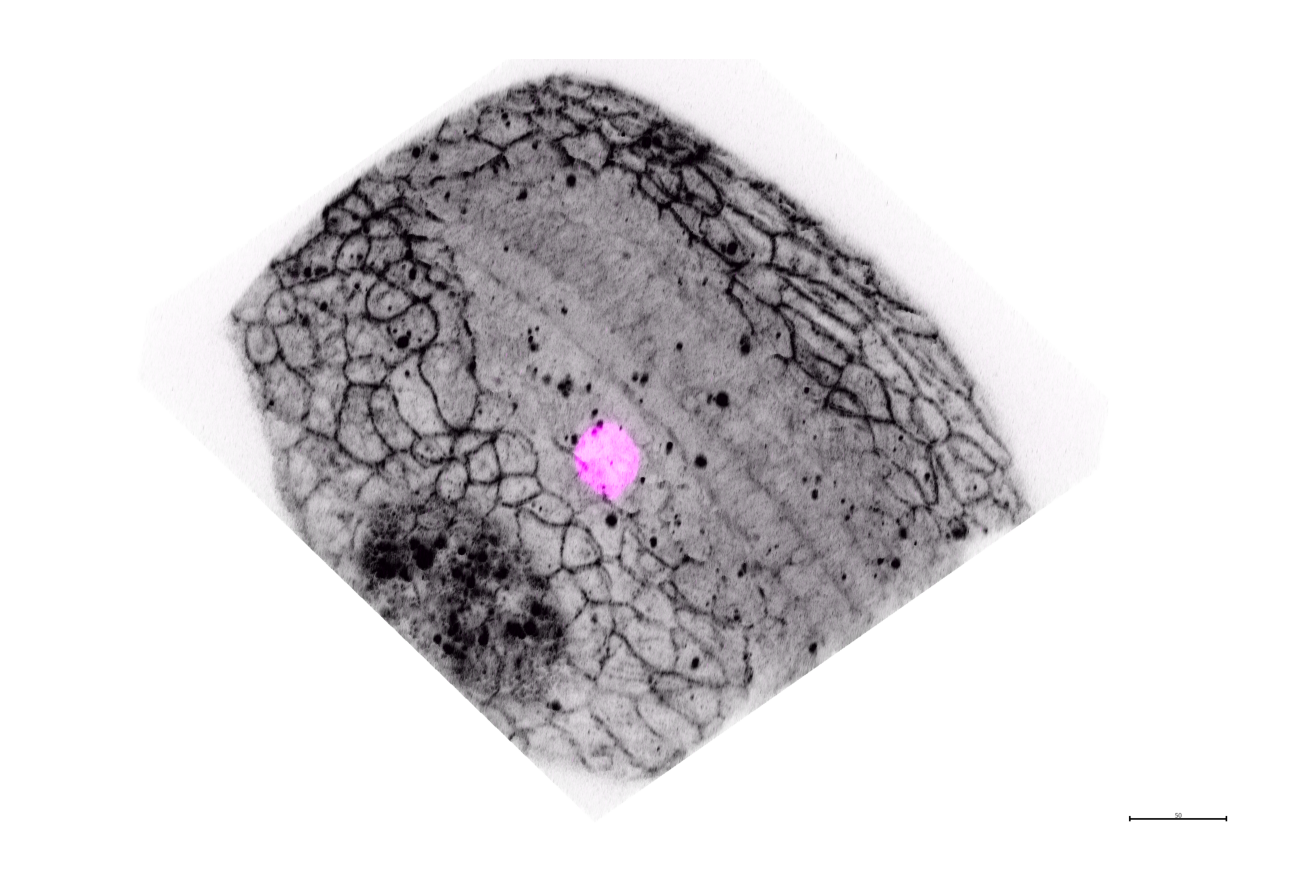
2D closeup#
viewer.dims.ndisplay = 2
viewer.window.resize(1400, 800)
viewer.camera.center = (0, 173, 234)
viewer.camera.zoom = 9
viewer.camera.angles = (0, 0, 90)
viewer.layers['membrane'].blending = 'translucent'
viewer.layers['membrane'].depicion = 'plane'
screenshot = viewer.screenshot(scale=figure_quality)
fig, ax = plt.subplots(figsize=(25*mm, 25*mm), dpi=300)
ax.imshow(screenshot)
ax.axis('off')
fig.tight_layout()
fig.savefig(os.path.join(figure_directory, 'droplet_membranes_2D_2D.png'), dpi=300, bbox_inches='tight', pad_inches=0)
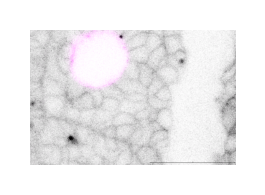
Label image#
make_layers_invisible(viewer)
viewer.dims.ndisplay = 3
viewer.scale_bar.visible = False
viewer.layers['Label image'].visible = True
viewer.window.resize(1100, 800)
viewer.camera.center = (26.082624545584775, 162.6613044365564, 194.46992893145662)
viewer.camera.zoom = 16
viewer.camera.angles = (-116, 53, -25)
screenshot = viewer.screenshot(scale=figure_quality)
fig, ax = plt.subplots(figsize=(30*mm, 30*mm), dpi=600)
ax.imshow(screenshot)
ax.axis('off')
fig.savefig(os.path.join(figure_directory, 'droplet_label.png'), dpi=500, bbox_inches='tight', pad_inches=0)
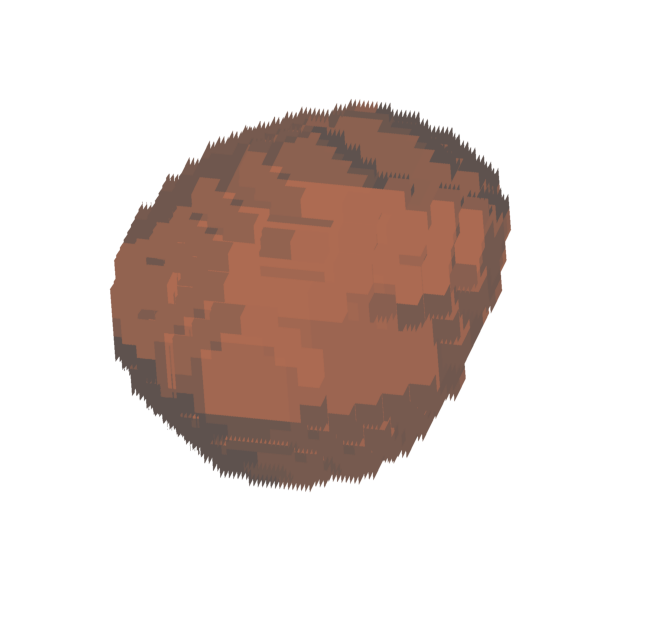
First guess#
def decimate_quadric(surface: 'napari.types.SurfaceData', number_of_vertices: int) -> 'napari.types.SurfaceData':
# decimate the surface to a certain number of vertices
mesh = vedo.Mesh((surface[0], surface[1]))
mesh = mesh.decimate(number_of_vertices)
return (mesh.vertices, np.array(mesh.cells, dtype=int))
def subdivide(surface: 'napari.types.SurfaceData', number_of_subdivisions: int) -> 'napari.types.SurfaceData':
# subdivide the surface
mesh = vedo.Mesh((surface[0], surface[1]))
mesh = mesh.subdivide(number_of_subdivisions)
return (mesh.vertices, np.array(mesh.cells, dtype=int))
def marching_cubes(data: "napari.types.LabelsData", level: float = 0.5) -> "napari.types.SurfaceData":
vertices, faces, _, _ = measure.marching_cubes(data, level=level)
return (vertices.astype(int), faces)
def smooth_surface(surface: "napari.types.SurfaceData", iterations: int = 15) -> "napari.types.SurfaceData":
mesh = vedo.Mesh([surface[0].astype(int), surface[1]])
mesh.smooth(niter=iterations, feature_angle=150)
return (mesh.vertices, np.asarray(mesh.cells))
make_layers_invisible(viewer)
surface = frame_by_frame(marching_cubes)(viewer.layers['Label image'].data)
surface_smooth = frame_by_frame(smooth_surface)(surface, 15)
surface_divided = frame_by_frame(subdivide)(surface_smooth, number_of_subdivisions=2)
viewer.add_surface(surface_divided, name='droplet surface subdivided', scale=[1, 2, 2, 2])
viewer.add_surface(surface_smooth, name='droplet surface', scale=[1, 2, 2, 2])
Converter = TimelapseConverter()
list_of_surfaces = Converter.data_to_list_of_data(surface_divided, layertype='napari.types.SurfaceData')
surface = list(list_of_surfaces[10])
surface[0] = surface[0] * 2
viewer.add_surface(surface)
viewer.layers[-1].colormap = 'coolwarm'
viewer.layers[-1].contrast_limits = [0, 0.1]
viewer.scale_bar.visible = True
viewer.scale_bar.fixed_width = 10
screenshot = viewer.screenshot(scale=figure_quality)
fig, ax = plt.subplots(figsize=(30*mm, 30*mm), dpi=300)
ax.imshow(screenshot)
ax.axis('off')
fig.savefig(os.path.join(figure_directory, 'droplet_surface_cut.png'), dpi=600, bbox_inches='tight', pad_inches=0)
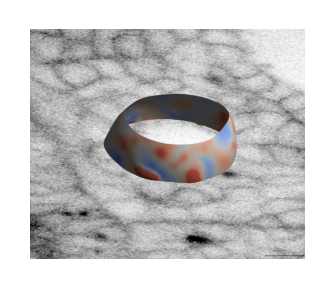
WARNING: QWindowsWindow::setGeometry: Unable to set geometry 202x430+1072+74 (frame: 218x469+1064+43) on QWidgetWindow/"Dock widget 1Window" on "\\.\DISPLAY49". Resulting geometry: 222x430+1072+74 (frame: 238x469+1064+43) margins: 8, 31, 8, 8 minimum size: 111x135 maximum size: 524287x524287 MINMAXINFO maxSize=0,0 maxpos=0,0 mintrack=238,309 maxtrack=1048590,1048613)
WARNING:vispy:QWindowsWindow::setGeometry: Unable to set geometry 202x430+1072+74 (frame: 218x469+1064+43) on QWidgetWindow/"Dock widget 1Window" on "\\.\DISPLAY49". Resulting geometry: 222x430+1072+74 (frame: 238x469+1064+43) margins: 8, 31, 8, 8 minimum size: 111x135 maximum size: 524287x524287 MINMAXINFO maxSize=0,0 maxpos=0,0 mintrack=238,309 maxtrack=1048590,1048613)
make_layers_invisible(viewer)
viewer.window.resize(1100, 800)
viewer.layers['droplet surface'].visible = True
viewer.layers['droplet surface points'].visible = True
screenshot = viewer.screenshot(scale=figure_quality)
fig, ax = plt.subplots(figsize=(30*mm, 30*mm), dpi=300)
ax.imshow(screenshot)
ax.axis('off')
fig.savefig(os.path.join(figure_directory, 'droplet_first_guess.png'), dpi=600, bbox_inches='tight', pad_inches=0)
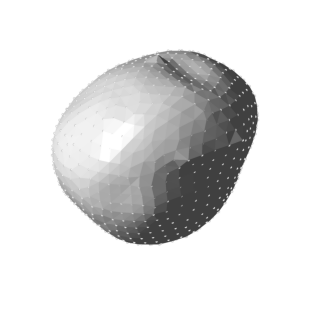
Trace vectors#
viewer.window.resize(1100, 800)
viewer.layers['Normals'].visible = True
viewer.layers['Normals'].edge_width = 0.2
viewer.layers['Normals'].length = 0.85
viewer.layers['Normals'].vector_style = 'arrow'
screenshot = viewer.screenshot(scale=figure_quality)
fig, ax = plt.subplots(figsize=(30*mm, 30*mm), dpi=300)
ax.imshow(screenshot)
ax.axis('off')
fig.savefig(os.path.join(figure_directory, 'droplet_normals.png'), dpi=500, bbox_inches='tight', pad_inches=0)
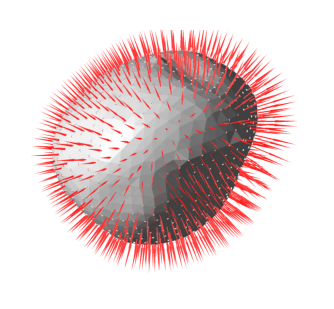
Reconstruction#
make_layers_invisible(viewer)
viewer.scale_bar.visible = True
viewer.scale_bar.fixed_width = 10
viewer.window.resize(1100, 800)
viewer.layers['droplet'].visible = True
viewer.layers['droplet'].depiction = 'volume'
viewer.layers['Droplet pointcloud (smoothed)'].visible = True
viewer.layers['droplet'].blending = 'translucent'
viewer.layers['droplet'].colormap = 'I Purple'
viewer.camera.center = (36, 150, 207)
viewer.camera.angles = (-50, 51, 87)
screenshot = viewer.screenshot(scale=figure_quality)
fig, ax = plt.subplots(figsize=(30*mm, 30*mm), dpi=300)
ax.imshow(screenshot)
ax.axis('off')
fig.savefig(os.path.join(figure_directory, 'droplet_refined.png'), dpi=300, bbox_inches='tight', pad_inches=0)
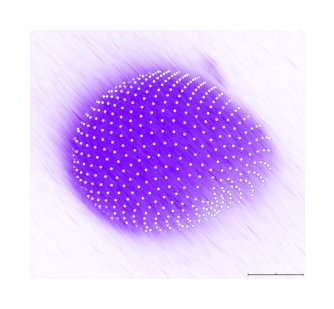
Total stress#
viewer.camera.angles = (-116, 53, -25)
viewer.camera.zoom = 18
viewer.camera.center = (29.15186330844246, 153.74747080708815, 208.32406186131644)
viewer.scale_bar.visible = False
make_layers_invisible(viewer)
viewer.window.resize(1100, 800)
viewer.layers['droplet'].blending = 'translucent'
viewer.layers['membrane'].visible = False
viewer.layers['Result of lebedev quadrature (droplet)'].visible = True
viewer.layers['Result of lebedev quadrature on ellipsoid'].visible = False
viewer.layers['Result of lebedev quadrature (droplet)'].blending = 'opaque'
viewer.layers['Result of lebedev quadrature (droplet)'].face_color = 'stress_total'
viewer.layers['Result of lebedev quadrature (droplet)'].face_colormap = 'coolwarm'
viewer.layers['Result of lebedev quadrature (droplet)'].face_contrast_limits = [-0.35, 0.35]
viewer.layers['Result of lebedev quadrature (droplet)'].refresh()
viewer.layers['Result of lebedev quadrature (droplet)'].size = 1
screenshot_total_stress = viewer.screenshot(scale=figure_quality)
fig, ax = plt.subplots(figsize=(40*mm, 40*mm), dpi=300)
ax.imshow(screenshot_total_stress)
ax.axis('off')
fig.savefig(os.path.join(figure_directory, "stress_total.png"), dpi=500, bbox_inches='tight', pad_inches=0)
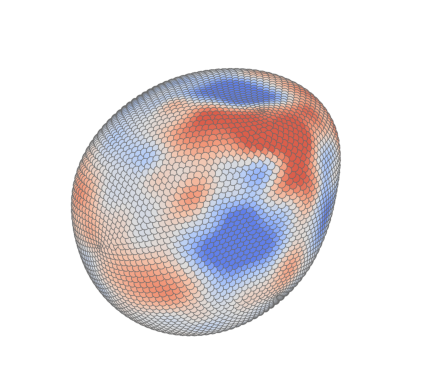
Cell stress#
viewer.layers['Result of lebedev quadrature (droplet)'].face_color = 'stress_cell'
viewer.layers['Result of lebedev quadrature (droplet)'].face_colormap = 'coolwarm'
viewer.layers['Result of lebedev quadrature (droplet)'].blending = 'opaque'
viewer.layers['Result of lebedev quadrature (droplet)'].face_contrast_limits = [-0.35, 0.35]
viewer.layers['Result of lebedev quadrature (droplet)'].refresh()
viewer.layers['Result of lebedev quadrature (droplet)'].size = 1
viewer.window.resize(1100, 800)
screenshot_cell_stress = viewer.screenshot(scale=figure_quality)
fig, ax = plt.subplots(figsize=(40*mm, 40*mm), dpi=300)
ax.imshow(screenshot_cell_stress)
ax.axis('off')
fig.savefig(os.path.join(figure_directory, "stress_cell.png"), dpi=500, bbox_inches='tight', pad_inches=0)
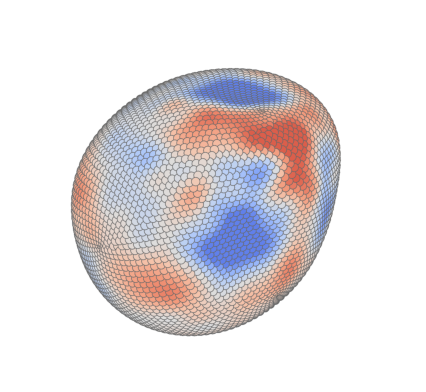
Tissue stress#
viewer.layers['Result of lebedev quadrature (droplet)'].visible = False
viewer.layers['Result of lebedev quadrature on ellipsoid'].visible = True
viewer.layers['Result of lebedev quadrature on ellipsoid'].face_color = 'stress_tissue'
viewer.layers['Result of lebedev quadrature on ellipsoid'].face_colormap = 'coolwarm'
viewer.layers['Result of lebedev quadrature on ellipsoid'].blending = 'opaque'
viewer.layers['Result of lebedev quadrature on ellipsoid'].face_contrast_limits = [-0.1, 0.1]
viewer.layers['Result of lebedev quadrature on ellipsoid'].refresh()
viewer.layers['Result of lebedev quadrature on ellipsoid'].size = 1
viewer.window.resize(1100, 800)
screenshot_tissue_stress = viewer.screenshot(scale=figure_quality)
fig, ax = plt.subplots(figsize=(40*mm, 40*mm), dpi=300)
ax.imshow(screenshot_tissue_stress)
ax.axis('off')
fig.tight_layout()
fig.savefig(os.path.join(figure_directory, "stress_tissue.png"), dpi=500, bbox_inches='tight', pad_inches=0)
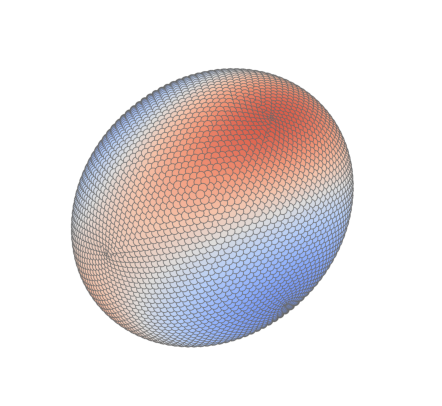
Extremal stress 3D#
viewer.window.resize(1100, 800)
viewer.camera.center = (35, 155, 207)
viewer.camera.angles = (-70, 30, 16)
viewer.layers['Result of lebedev quadrature (droplet)'].visible = True
viewer.layers['Result of lebedev quadrature on ellipsoid'].visible = False
viewer.layers['Result of lebedev quadrature (droplet)'].size = 1
viewer.layers['Total stress: Geodesics maxima -> nearest minima'].visible = True
viewer.layers['Total stress: Geodesics maxima -> nearest minima'].edge_width = 0.8
viewer.layers['Total stress: Geodesics maxima -> nearest minima'].blending = 'opaque'
viewer.layers['Total stress: Geodesics minima -> nearest maxima'].visible = True
viewer.layers['Total stress: Geodesics minima -> nearest maxima'].edge_width = 0.8
viewer.layers['Total stress: Geodesics minima -> nearest maxima'].blending = 'opaque'
viewer.layers['Result of lebedev quadrature (droplet)'].face_color = 'stress_total_extrema'
viewer.layers['Result of lebedev quadrature (droplet)'].blending = 'opaque'
viewer.layers['Result of lebedev quadrature (droplet)'].face_colormap = 'coolwarm'
viewer.layers['Result of lebedev quadrature (droplet)'].face_contrast_limits = [-1, 1]
viewer.layers['Result of lebedev quadrature (droplet)'].refresh()
screenshot_nearest_extrema_3d = viewer.screenshot(scale=figure_quality)
fig, ax = plt.subplots(figsize=(35*mm, 35*mm), dpi=300)
ax.imshow(screenshot_nearest_extrema_3d)
ax.axis('off')
fig.tight_layout()
fig.savefig(os.path.join(figure_directory, "droplet_nearest_extrema_3d.png"), dpi=500, bbox_inches='tight', pad_inches=0)
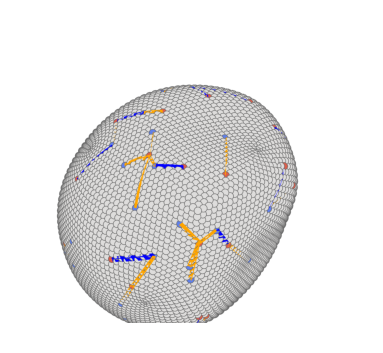
Advanced visualizations#
In this section, we create some advanced visualizations to highlight the interplay between the obtained measurements and their biological relevance.
set_timepoint(viewer, 4)
viewer.camera.center = (35,147,209)
viewer.camera.angles = (-57, 40, 112)
viewer.camera.zoom = 11
viewer.scale_bar.visible = True
viewer.scale_bar.fixed_width = 25
viewer.layers['membrane'].visible = True
viewer.layers['membrane'].plane.position = (7.5, 443, 697)
viewer.layers['membrane'].rendering = 'additive'
viewer.layers['membrane'].depiction = 'plane'
viewer.layers['Result of lebedev quadrature (droplet)'].visible = True
viewer.layers['Result of lebedev quadrature on ellipsoid'].visible = False
viewer.layers['Result of lebedev quadrature (droplet)'].size = 1
viewer.layers['Total stress: Geodesics maxima -> nearest minima'].visible = True
viewer.layers['Total stress: Geodesics maxima -> nearest minima'].vector_style = 'line'
viewer.layers['Total stress: Geodesics maxima -> nearest minima'].edge_width = 0.8
viewer.layers['Total stress: Geodesics minima -> nearest maxima'].visible = True
viewer.layers['Total stress: Geodesics minima -> nearest maxima'].edge_width = 0.8
viewer.layers['Total stress: Geodesics minima -> nearest maxima'].vector_style = 'line'
viewer.layers['Result of lebedev quadrature (droplet)'].face_color = 'stress_total_extrema'
viewer.layers['Result of lebedev quadrature (droplet)'].face_colormap = 'coolwarm'
viewer.layers['Result of lebedev quadrature (droplet)'].face_contrast_limits = [-1, 1]
viewer.layers['Result of lebedev quadrature (droplet)'].refresh()
screenshot_nearest_extrema_3d = viewer.screenshot(scale=figure_quality)
fig, ax = plt.subplots(figsize=(40*mm, 40*mm), dpi=300)
ax.axis('off')
ax.imshow(screenshot_nearest_extrema_3d)
fig.savefig(os.path.join(figure_directory, "droplet_membrane_nearest_extrema_3d.png"), dpi=500, bbox_inches='tight', pad_inches=0)
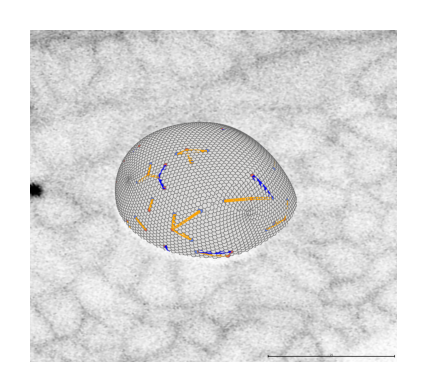
make_layers_invisible(viewer)
viewer.layers['membrane'].visible = True
viewer.layers['membrane'].depiction='volume'
viewer.layers['membrane'].blending = 'translucent'
viewer.layers['membrane'].rendering = 'mip'
viewer.layers['droplet'].visible = True
viewer.layers['droplet'].depiction='volume'
viewer.layers['droplet'].blending = 'minimum'
viewer.layers['droplet'].rendering = 'mip'
viewer.layers['membrane'].visible = True
viewer.layers['droplet'].visible = True
viewer.layers['membrane'].depiction = 'volume'
viewer.layers['droplet'].depiction = 'volume'
viewer.layers['fit_ellipsoid_to_pointcloud result'].visible = True
viewer.layers['fit_ellipsoid_to_pointcloud result'].vector_style = 'arrow'
viewer.layers['fit_ellipsoid_to_pointcloud result'].edge_width = 1.0
viewer.layers['fit_ellipsoid_to_pointcloud result'].blending = 'translucent_no_depth'
viewer.window.resize(1100, 800)
viewer.camera.center=(35.0, 147.0, 209.0)
viewer.camera.zoom=6
viewer.camera.angles=(-64.56521800938883, 31.49268860197681, 98.06097255964103)
screenshot = viewer.screenshot(scale=figure_quality)
fig, ax = plt.subplots(figsize=(35*mm, 35*mm), dpi=300)
ax.axis('off')
ax.imshow(screenshot)
fig.savefig(os.path.join(figure_directory, "major_axess_orientation.png"), dpi=300, bbox_inches='tight', pad_inches=0)
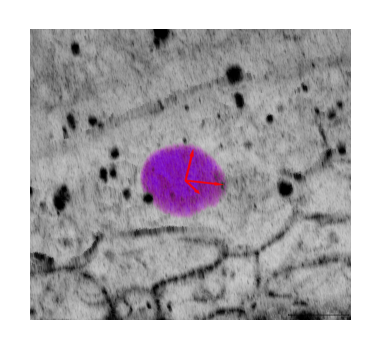
Plots#
In this section, we produce the plots for the figure in the paper that compare key results between the two implementations, namely: The total/cellular/tissue stresses, the spatial autocorrelations
# Compile data
df_over_time, df_nearest_pairs, df_all_pairs, df_autocorrelations = utils.compile_data_from_layers(
results_stress_analysis, n_frames=n_frames, time_step=time_step)
Quantitative plots#
In this section we create some quantitiative plots which demonstrate the match between the two implementations. Most noteably, we compare the total, cellular and tissue stress anisotropies as well as the spatial autocorrelation of the total stress.
#max_time = (image[:, :, 1].shape[0] - 1) * time_step
max_time = 60
ylims_stress = [-0.1, 0.65]
drop = viewer.layers['Result of lebedev quadrature on ellipsoid'].data
center = [drop[drop[:,0] == t].mean(axis=0) for t in np.arange(n_frames)]
radius = np.mean([np.sqrt(((drop[drop[:,0] == t] - center[t])**2).sum(axis=1)).mean() for t in np.arange(n_frames)])
Stress anisotropies:#
For total, cell & tissue stress, the Matlab-based implementation yields the following results:
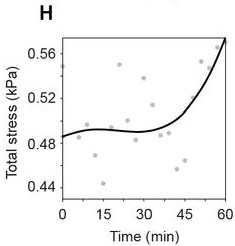
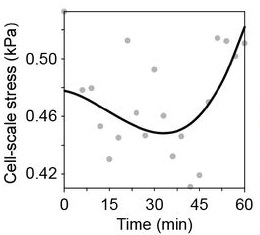
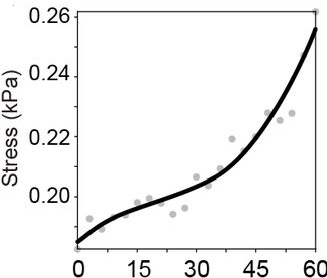
…and these are the result of the napari-stress based implementation (note the different axis limits). As you can see, the results are very similar down to the second decimal place (~10kPa).
df_STRESS = pd.DataFrame()
for file in os.listdir('./results_STRESS/'):
# read from file with data stored in row direction
single_result = pd.read_csv(f'./results_STRESS/{file}', header=None).T
column_name = file.split('.')[0]
df_STRESS[column_name] = single_result.values.flatten()
to_compare = ['stress_total_anisotropy', 'stress_cell_anisotropy', 'stress_tissue_anisotropy']
for item in to_compare:
difference_absolute = df_STRESS[item] - df_over_time[item]
difference_relative = np.abs(difference_absolute) / df_over_time[item]
df_over_time[f'{item}_difference_absolute'] = difference_absolute
df_over_time[f'{item}_difference_relative'] = difference_relative
print(f"Mean absolute difference for {item}: {difference_absolute.mean()} $\pm$ {difference_absolute.std()}")
print(f"Mean relative difference for {item}: {difference_relative.mean()} $\pm$ {difference_relative.std()}")
Mean absolute difference for stress_total_anisotropy: 0.01471615428906991 $\pm$ 0.026013036408353413
Mean relative difference for stress_total_anisotropy: 0.04483832581735439 $\pm$ 0.0419828383966144
Mean absolute difference for stress_cell_anisotropy: 0.011845047924721793 $\pm$ 0.024976115952038407
Mean relative difference for stress_cell_anisotropy: 0.04533689384174737 $\pm$ 0.039536128889490846
Mean absolute difference for stress_tissue_anisotropy: 0.008569460469151512 $\pm$ 0.0035495001129169103
Mean relative difference for stress_tissue_anisotropy: 0.04268369789244 $\pm$ 0.016014770602567712
fig, axes = plt.subplots(ncols=3, figsize=(90*mm, 30*mm), dpi=300, sharex=True, sharey=True)
sns.lineplot(data=df_over_time, x='time', y='stress_total_anisotropy', ax=axes[0],
markers=True, dashes=False, marker='o', markersize=0.5, linewidth=1)
sns.lineplot(data=df_over_time, x='time', y='stress_cell_anisotropy', ax=axes[1],
markers=True, dashes=False, marker='o', markersize=0.5, linewidth=1)
sns.lineplot(data=df_over_time, x='time', y='stress_tissue_anisotropy', ax=axes[2],
markers=True, dashes=False, marker='o', markersize=0.5, linewidth=1)
# abolsute differences
sns.lineplot(data=df_over_time, x='time', y='stress_total_anisotropy_difference_absolute', ax=axes[0], linewidth=1, markers='o', markersize=0.5)
sns.lineplot(data=df_over_time, x='time', y='stress_cell_anisotropy_difference_absolute', ax=axes[1], linewidth=1, markers='o', markersize=0.5)
sns.lineplot(data=df_over_time, x='time', y='stress_tissue_anisotropy_difference_absolute', ax=axes[2], linewidth=1, markers='o', markersize=0.5)
for ax in axes:
ax.set_xlim([0, max_time])
ax.set_xlabel("Time (min)", fontsize=fs)
ax.set_ylim(ylims_stress)
ax.set_ylabel("Stress (kPa)", fontsize=5)
ax.hlines(0, 0, max_time, color='black', linestyle='--', linewidth=0.5)
# set fontsize of ticks
ax.tick_params(axis='both', which='major', labelsize=fs)
fig.tight_layout()
fig.savefig(
os.path.join(figure_directory, 'droplet_stress_anisotropy_all_over_time.pdf'),
dpi=300,
bbox_inches='tight')
WARNING:fontTools.subset:meta NOT subset; don't know how to subset; dropped

Spatial autocorrelations#
The spatial autocorrelations for total and cellular stresses are reported as follows using the Matlab-based implementation:
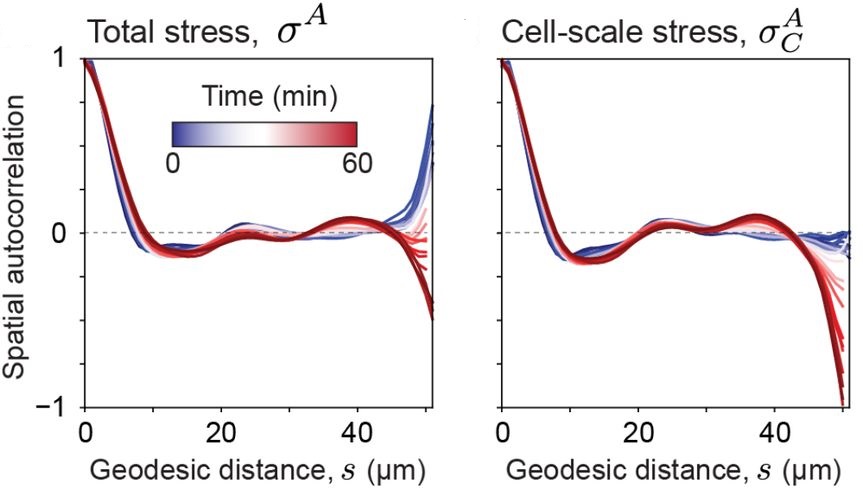
…and the napari-stress based implementation yields the following result for the total stress and cell stress:
fig, axes = plt.subplots(ncols=2, figsize=(90*mm, 40*mm), dpi=300, sharex=True, sharey=True)
mappable = plt.cm.ScalarMappable(cmap='coolwarm', norm=plt.Normalize(vmin=0,
vmax=df_autocorrelations.time.max()))
sns.lineplot(data=df_autocorrelations, x='distances', y='autocorrelations_spatial_total',
hue='time', ax=axes[0], palette='coolwarm', legend=False, linewidth=0.5)
sns.lineplot(data=df_autocorrelations, x='distances', y='autocorrelations_spatial_cell',
hue='time', ax=axes[1], palette='coolwarm', legend=False, linewidth=0.5)
for ax in axes:
ax.set_xlabel("Geodesic distance $s$ [µm]", fontsize=fs)
ax.set_ylabel("Spatial autocorrelation", fontsize=fs)
ax.set_xlim([0, df_autocorrelations['distances'].max()])
ax.set_ylim([-1, 1])
ax.hlines(0, 0, df_autocorrelations['distances'].max(), linestyle='--', color='gray',
alpha=0.5)
ax.tick_params(axis='both', which='major', labelsize=fs)
fig.tight_layout()
cbar = fig.colorbar(mappable, ax=np.asarray(fig.axes).ravel().tolist())
cbar.set_label('Time [min]', fontsize=fs)
cbar.set_ticklabels(cbar.get_ticks().astype(int), fontsize=fs)
fig.savefig(os.path.join(figure_directory, 'droplet_spatial_autocorrelation_total_cell.pdf'), dpi=300, bbox_inches='tight')
WARNING:fontTools.subset:meta NOT subset; don't know how to subset; dropped
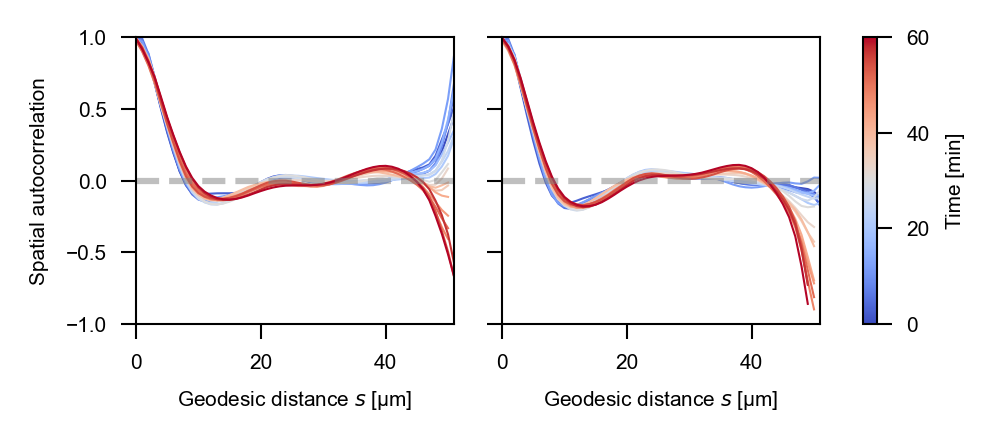
Geodesic distances#
fig, axes = plt.subplots(ncols=4, nrows=1, figsize=(110*mm, 30*mm), dpi=300)
axes = axes.flatten()
sns.histplot(data=df_all_pairs, x='stress_cell_all_pair_distance', ax=axes[0], stat='density')
axes[0].set_xlabel("", fontsize=fs)
axes[0].set_ylabel("Counts (#)", fontsize=fs)
sns.histplot(data=df_nearest_pairs, x='stress_cell_nearest_pair_distance', ax=axes[1], alpha=0.5)
axes[1].set_xlabel("Geodesic distance, $s$ ($\mu m$)", fontsize=fs)
axes[1].set_ylabel("Counts [#]", fontsize=fs)
# Stress anisotropies (all pairs)
sns.histplot(data=df_all_pairs, x='stress_cell_all_pair_anisotropy', ax=axes[2])
axes[2].set_xlabel("", fontsize=fs)
axes[2].set_ylabel("", fontsize=fs)
# Stress anisotropies (nearest pairs)
sns.histplot(data=df_nearest_pairs, x='stress_cell_nearest_pair_anisotropy', ax=axes[3])
axes[3].set_xlabel("Stress anisotropy, $\sigma_A^C$ (kPa)", fontsize=fs)
axes[3].set_ylabel("", fontsize=fs)
for ax in axes:
#ax.set_xlim([0, df_all_pairs['stress_cell_all_pair_distance'].max()])
ax.tick_params(axis='both', which='major', labelsize=fs)
fig.tight_layout()
fig.align_xlabels()
fig.savefig(os.path.join(figure_directory, 'spatial_autocorrelation_all_nearest_pair_distance.pdf'), dpi=300, bbox_inches='tight')
WARNING:fontTools.subset:meta NOT subset; don't know how to subset; dropped

Temporal autocorrelations#
fig, axes = plt.subplots(ncols=3, figsize=(90*mm, 30*mm), dpi=300, sharex=True, sharey=True)
sns.lineplot(df_over_time, x='time', y='autocorrelations_temporal_total', ax=axes[0], marker='o', markersize=.5, linewidth=1)
sns.lineplot(df_over_time, x='time', y='autocorrelations_temporal_cell', ax=axes[1], marker='o', markersize=.5, linewidth=1)
sns.lineplot(df_over_time, x='time', y='autocorrelations_temporal_tissue', ax=axes[2], marker='o', markersize=.5, linewidth=1)
for ax in axes:
ax.set_xlim([0, max_time])
ax.set_ylim([-1, 1])
ax.hlines(0, 0, max_time, linestyle='--', color='gray', alpha=0.5, linewidth=1)
ax.set_xlabel("Time [min]", fontsize=fs)
ax.set_ylabel("Temporal autocorrelation", fontsize=fs)
ax.tick_params(axis='both', which='major', labelsize=fs)
fig.tight_layout()
fig.savefig(os.path.join(figure_directory, 'temporal_autocorrelation_all.pdf'), dpi=300, bbox_inches='tight')

Composite figure#
# set global labelpad and ticklabel padding
plt.rcParams['axes.labelpad'] = 0
plt.rcParams['xtick.major.pad'] = 1
# all fonts arial
plt.rcParams['font.family'] = 'sans-serif'
plt.rcParams['font.sans-serif'] = 'Arial'
from matplotlib.ticker import ScalarFormatter
time_ticks = [0, 20, 40, 60]
fig, axes = plt.subplots(figsize=(90*mm, 100*mm), dpi=300, nrows=4, ncols=3)
# top row stresses
sns.lineplot(data=df_over_time, x='time', y='stress_total_anisotropy', ax=axes[0, 0],
markers=True, dashes=False, marker='o', markersize=0.5, linewidth=1)
sns.lineplot(data=df_over_time, x='time', y='stress_cell_anisotropy', ax=axes[0, 1],
markers=True, dashes=False, marker='o', markersize=0.5, linewidth=1)
sns.lineplot(data=df_over_time, x='time', y='stress_tissue_anisotropy', ax=axes[0, 2],
markers=True, dashes=False, marker='o', markersize=0.5, linewidth=1)
# abolsute differences
sns.lineplot(data=df_over_time, x='time', y='stress_total_anisotropy_difference_absolute', ax=axes[0, 0], linewidth=1, markers='o', markersize=0.5)
sns.lineplot(data=df_over_time, x='time', y='stress_cell_anisotropy_difference_absolute', ax=axes[0, 1], linewidth=1, markers='o', markersize=0.5)
sns.lineplot(data=df_over_time, x='time', y='stress_tissue_anisotropy_difference_absolute', ax=axes[0, 2], linewidth=1, markers='o', markersize=0.5)
axes[0, 0].set_title("Total stress, $\sigma_A$", fontsize=fs)
axes[0, 1].set_title("Cell stress, $\sigma_A^C$", fontsize=fs)
axes[0, 2].set_title("Tissue stress, $\sigma_A^T$", fontsize=fs)
axes[0, 0].set_ylabel("Stress, $\sigma_A$, (kPa)", fontsize=fs)
axes[0, 1].set_ylabel(None, fontsize=fs)
axes[0, 2].set_ylabel(None, fontsize=fs)
# For first row, specifically
for idx, ax in enumerate(axes[0, :]):
ax.set_xlim([0, max_time])
ax.set_ylim(ylims_stress)
ax.hlines(0, 0, max_time, color='black', linestyle='--', linewidth=0.5, alpha=0.5)
ax.set_xlabel(None)
ax.set_xticks(time_ticks)
# Temporal autocorrelations
sns.lineplot(df_over_time, x='time', y='autocorrelations_temporal_total', ax=axes[1, 0], marker='o', markersize=.5, linewidth=1)
sns.lineplot(df_over_time, x='time', y='autocorrelations_temporal_cell', ax=axes[1, 1], marker='o', markersize=.5, linewidth=1)
sns.lineplot(df_over_time, x='time', y='autocorrelations_temporal_tissue', ax=axes[1, 2], marker='o', markersize=.5, linewidth=1)
for idx, ax in enumerate(axes[1, :]):
ax.set_xlim([0, max_time])
ax.set_ylim([-1, 1])
ax.hlines(0, 0, max_time, color='black', linestyle='--', linewidth=0.5, alpha=0.5)
ax.set_xlabel("Time (min)", fontsize=fs)
ax.set_ylabel("Temporal autocorrelation", fontsize=fs)
for ax in axes[:2, 1:].flatten():
ax.set_yticklabels([])
ax.set_ylabel(None)
# Spatial neighbors
sns.histplot(data=df_all_pairs, x='stress_cell_all_pair_distance', ax=axes[2, 0], stat='density')
axes[2, 0].set_xlabel("", fontsize=fs)
axes[2, 0].set_ylabel("Counts (#)", fontsize=fs)
sns.histplot(data=df_nearest_pairs, x='stress_cell_nearest_pair_distance', ax=axes[2, 1], alpha=0.5, stat='density')
axes[2, 1].set_xlabel("Geodesic distance, $s$ ($\mu m$)", fontsize=fs)
axes[2, 1].set_ylabel(None)
# use scientifc notation for y-axis tick labels (i.e., 1e-2)
for ax in axes[2:, :2].flatten():
#ax.yaxis.set_major_formatter(ScalarFormatter(useMathText=True))
ax.ticklabel_format(axis='y', style='sci', scilimits=(0, 0))
ax.yaxis.offsetText.set_fontsize(fs)
# Stress anisotropies (all pairs)
sns.histplot(data=df_all_pairs, x='stress_cell_all_pair_anisotropy', ax=axes[3, 0], stat='density')
axes[3, 0].set_xlabel(None)
axes[3, 0].set_ylabel(None)
# Stress anisotropies (nearest pairs)
sns.histplot(data=df_nearest_pairs, x='stress_cell_nearest_pair_anisotropy', ax=axes[3, 1], stat='density')
axes[3, 1].set_xlabel("Stress anisotropy, $\sigma_A^C$ (kPa)", fontsize=fs)
axes[3, 1].set_ylabel(None, fontsize=fs)
# Spatial autocorrelations
sns.lineplot(data=df_autocorrelations, x='distances', y='autocorrelations_spatial_total',
hue='time', ax=axes[2, 2], palette='coolwarm', legend=False, linewidth=0.5)
sns.lineplot(data=df_autocorrelations, x='distances', y='autocorrelations_spatial_cell',
hue='time', ax=axes[3, 2], palette='coolwarm', legend=False, linewidth=0.5)
axes[2, 2].set_ylabel(None)
axes[2, 2].set_xlabel(None)
axes[3, 2].set_ylabel("Spatial autocorrelation", fontsize=fs)
axes[3, 2].set_xlabel("Geodesic distance, $s$ (µm)", fontsize=fs)
for ax in axes[2:, 2].flatten():
ax.set_xlim([0, df_autocorrelations['distances'].max()])
ax.set_ylim([-1, 1])
ax.hlines(0, 0, df_autocorrelations['distances'].max(), linestyle='--', linewidth=0.5, alpha=0.5)
# For all axes
for ax in axes.flatten():
#ax.set_xlabel("Time [min]", fontsize=fs)
#ax.set_ylabel("Temporal autocorrelation", fontsize=fs)
ax.tick_params(axis='both', which='major', labelsize=fs)
fig.align_ylabels()
fig.tight_layout(h_pad=0.0, w_pad=0.0)
fig.align_ylabels()
fig.savefig(os.path.join(figure_directory, 'droplet_all.pdf'), dpi=300, bbox_inches='tight')
WARNING:fontTools.subset:meta NOT subset; don't know how to subset; dropped
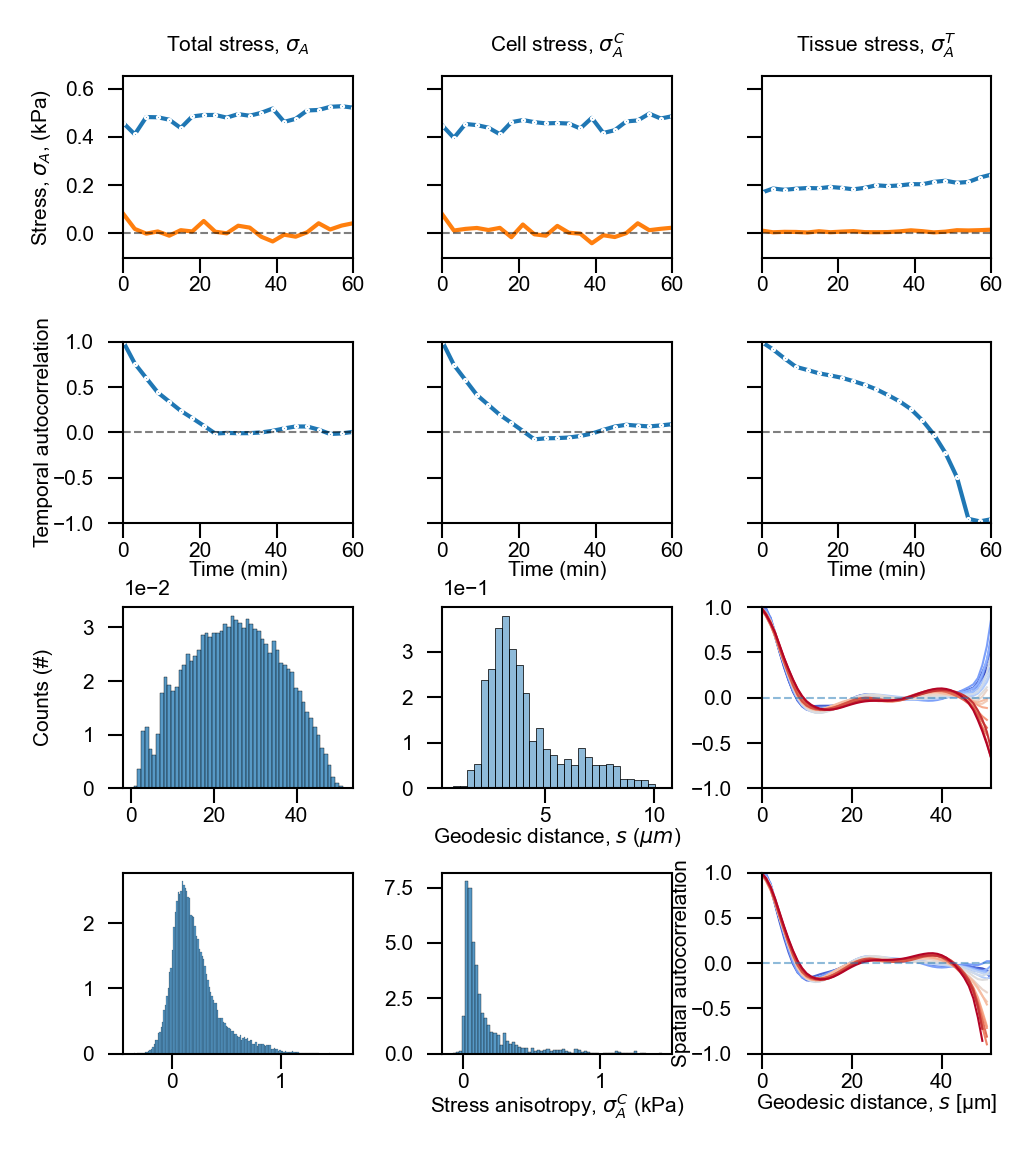
2024-07-26 10:34:45,003 - tornado.application - ERROR - Uncaught exception GET /status/ws (127.0.0.1)
HTTPServerRequest(protocol='http', host='127.0.0.1:8787', method='GET', uri='/status/ws', version='HTTP/1.1', remote_ip='127.0.0.1')
Traceback (most recent call last):
File "c:\Users\Johannes\mambaforge\envs\stress\lib\site-packages\tornado\websocket.py", line 937, in _accept_connection
open_result = handler.open(*handler.open_args, **handler.open_kwargs)
File "c:\Users\Johannes\mambaforge\envs\stress\lib\site-packages\tornado\web.py", line 3290, in wrapper
return method(self, *args, **kwargs)
File "c:\Users\Johannes\mambaforge\envs\stress\lib\site-packages\bokeh\server\views\ws.py", line 149, in open
raise ProtocolError("Token is expired.")
bokeh.protocol.exceptions.ProtocolError: Token is expired.
